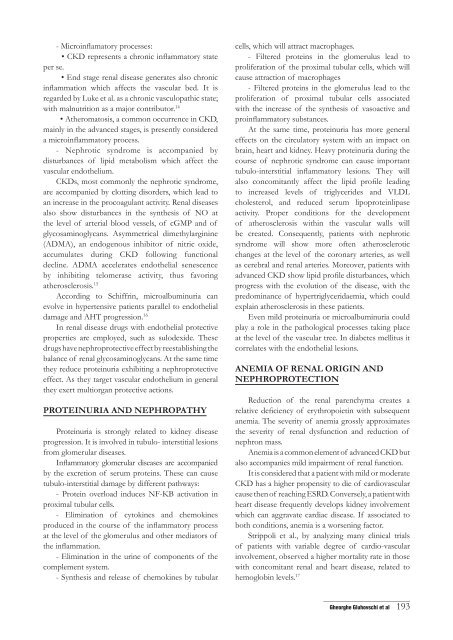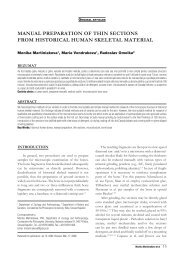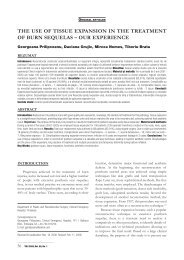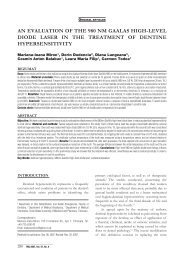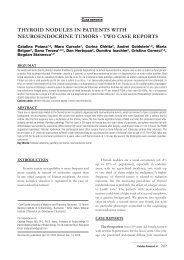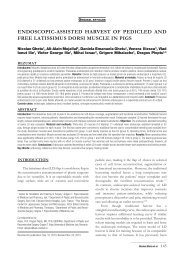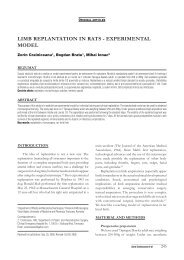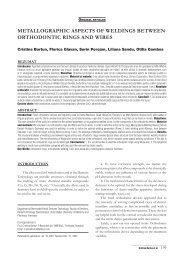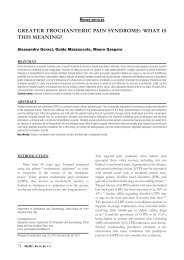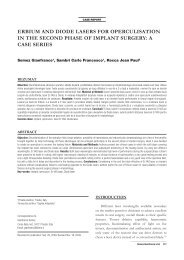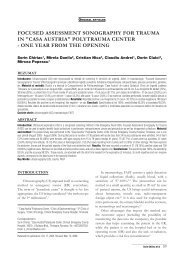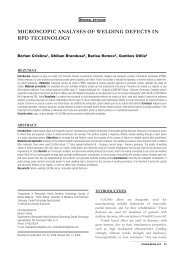nEPHroProtEction, Part oF MULti-orGan ProtEction
nEPHroProtEction, Part oF MULti-orGan ProtEction
nEPHroProtEction, Part oF MULti-orGan ProtEction
Create successful ePaper yourself
Turn your PDF publications into a flip-book with our unique Google optimized e-Paper software.
- Microinflamatory processes:<br />
• CKD represents a chronic inflammatory state<br />
per se.<br />
• End stage renal disease generates also chronic<br />
inflammation which affects the vascular bed. It is<br />
regarded by Luke et al. as a chronic vasculopathic state;<br />
with malnutrition as a major contributor. 14<br />
• Atheromatosis, a common occurrence in CKD,<br />
mainly in the advanced stages, is presently considered<br />
a microinflammatory process.<br />
- Nephrotic syndrome is accompanied by<br />
disturbances of lipid metabolism which affect the<br />
vascular endothelium.<br />
CKDs, most commonly the nephrotic syndrome,<br />
are accompanied by clotting disorders, which lead to<br />
an increase in the procoagulant activity. Renal diseases<br />
also show disturbances in the synthesis of NO at<br />
the level of arterial blood vessels, of cGMP and of<br />
glycosaminoglycans. Asymmetrical dimethylarginine<br />
(ADMA), an endogenous inhibitor of nitric oxide,<br />
accumulates during CKD following functional<br />
decline. ADMA accelerates endothelial senescence<br />
by inhibiting telomerase activity, thus favoring<br />
atherosclerosis. 15<br />
According to Schiffrin, microalbuminuria can<br />
evolve in hypertensive patients parallel to endothelial<br />
damage and AHT progression. 16<br />
In renal disease drugs with endothelial protective<br />
properties are employed, such as sulodexide. These<br />
drugs have nephroprotective effect by reestablishing the<br />
balance of renal glycosaminoglycans. At the same time<br />
they reduce proteinuria exhibiting a nephroprotective<br />
effect. As they target vascular endothelium in general<br />
they exert multiorgan protective actions.<br />
ProtEinUria and nEPHroPatHy<br />
Proteinuria is strongly related to kidney disease<br />
progression. It is involved in tubulo- interstitial lesions<br />
from glomerular diseases.<br />
Inflammatory glomerular diseases are accompanied<br />
by the excretion of serum proteins. These can cause<br />
tubulo-interstitial damage by different pathways:<br />
- Protein overload induces NF-KB activation in<br />
proximal tubular cells.<br />
- Elimination of cytokines and chemokines<br />
produced in the course of the inflammatory process<br />
at the level of the glomerulus and other mediators of<br />
the inflammation.<br />
- Elimination in the urine of components of the<br />
complement system.<br />
- Synthesis and release of chemokines by tubular<br />
cells, which will attract macrophages.<br />
- Filtered proteins in the glomerulus lead to<br />
proliferation of the proximal tubular cells, which will<br />
cause attraction of macrophages<br />
- Filtered proteins in the glomerulus lead to the<br />
proliferation of proximal tubular cells associated<br />
with the increase of the synthesis of vasoactive and<br />
proinflammatory substances.<br />
At the same time, proteinuria has more general<br />
effects on the circulatory system with an impact on<br />
brain, heart and kidney. Heavy proteinuria during the<br />
course of nephrotic syndrome can cause important<br />
tubulo-interstitial inflammatory lesions. They will<br />
also concomitantly affect the lipid profile leading<br />
to increased levels of triglycerides and VLDL<br />
cholesterol, and reduced serum lipoproteinlipase<br />
activity. Proper conditions for the development<br />
of atherosclerosis within the vascular walls will<br />
be created. Consequently, patients with nephrotic<br />
syndrome will show more often atherosclerotic<br />
changes at the level of the coronary arteries, as well<br />
as cerebral and renal arteries. Moreover, patients with<br />
advanced CKD show lipid profile disturbances, which<br />
progress with the evolution of the disease, with the<br />
predominance of hypertriglyceridaemia, which could<br />
explain atherosclerosis in these patients.<br />
Even mild proteinuria or microalbuminuria could<br />
play a role in the pathological processes taking place<br />
at the level of the vascular tree. In diabetes mellitus it<br />
correlates with the endothelial lesions.<br />
anEMia <strong>oF</strong> rEnaL oriGin and<br />
<strong>nEPHro<strong>ProtEction</strong></strong><br />
Reduction of the renal parenchyma creates a<br />
relative deficiency of erythropoietin with subsequent<br />
anemia. The severity of anemia grossly approximates<br />
the severity of renal dysfunction and reduction of<br />
nephron mass.<br />
Anemia is a common element of advanced CKD but<br />
also accompanies mild impairment of renal function.<br />
It is considered that a patient with mild or moderate<br />
CKD has a higher propensity to die of cardiovascular<br />
cause then of reaching ESRD. Conversely, a patient with<br />
heart disease frequently develops kidney involvement<br />
which can aggravate cardiac disease. If associated to<br />
both conditions, anemia is a worsening factor.<br />
Strippoli et al., by analyzing many clinical trials<br />
of patients with variable degree of cardio-vascular<br />
involvement, observed a higher mortality rate in those<br />
with concomitant renal and heart disease, related to<br />
hemoglobin levels. 17<br />
_____________________________<br />
Gheorghe Gluhovschi et al 193


